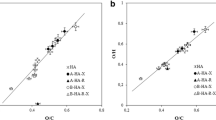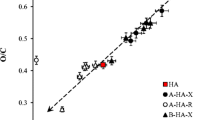Abstract
Fluoride (F−) binding to humic acid has been measured as a function of pH (5–6.6). The pH dependent binding is attributed to the anion being trapped within the large structure (territorial bound) but is not bound to a particular functional group (site bound). Studying fluoride binding provides insight to cation, anion and neutral species interactions with humic acid.
Similar content being viewed by others
References
E.M. Thurman, R.L. Malcolm,Environ. Sci. Tech., (1981) 463.
G.R. Choppin,Radiochim. Acta, (1988) 23.
E.M. Thurman, R.L. Wershaw, R.L. Malcolm, D.J. Pinckney,Org. Geochem., (1982) 27.
M. Schnitzer, S.U. Khan, Humic Substances in the Environment, Marcel Dekker, NY, 1972, pp. 327.
J.J. Rook,Environ. Sci. Tech., (1977) 478.
D.E. Illman,Chem. Eng. News, June 21 (1993) 9.
M. Aziz et al.,Radio. Waste Mang. Env. Rest., (1994) 243.
G.S. Manning,Radiochim. Acta., (1969) 519.
R.A. Torres, G.R. Choppin,Radiochim. Acta, (1976) 143.
E.D. Gravley, T.J. Manning,Florida Scientist (1995) (In press).
G.R. Choppin, P. Shanbhag,J. Inorg. Nucl. Chem., (1981) 921.
A. martell, P. Smith, R. Motekaitis, NIST Critical Stability Constants of Metal Complexes Database, (1993) NIST software.
R.K. Rastogi et al.,J. Radioanal. Nucl. Chem., Letters, (1994) 291.
Author information
Authors and Affiliations
Rights and permissions
About this article
Cite this article
Hayes, D., Carter, J. & Manning, T.J. Fluoride binding to humic acid. Journal of Radioanalytical and Nuclear Chemistry Letters 201, 135–141 (1995). https://doi.org/10.1007/BF02163725
Received:
Accepted:
Issue Date:
DOI: https://doi.org/10.1007/BF02163725




